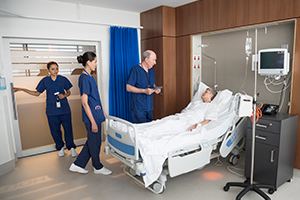Interventional Care


We notice that you are visiting us from . This site only services US-based visitors. Would you like to visit the site that is appropriate for your location?

An admission to the hospital is an unnerving experience for both patients and their families. Patients are hopeful that their hospital experience will mitigate the issues surrounding their illness. However, that is often not the outcome. Statistics show that the hospital environment itself may be the cause of additional infections and subsequent illnesses. According to the Centers for Disease Control and Prevention (CDC), an alarming 1 in 25 hospitalized patients acquire at least one healthcare-associated infection (HAI).(1.)
Countless hours and dollars are spent trying to identify the perfect solution in eliminating HAIs, including new and advanced products and technologies. There are studies that show the resilience of microorganisms and the latest technologies to help combat these infections. There are also specialists and committees set up to identify the appropriate products to help solve these problems. However, it seems the infections keep coming back, stronger and more resilient than ever.
The key is to remain vigilant and not get caught up in looking for that “one perfect solution” while overlooking the basics of cleaning and disinfection. Utilizing the right products and technologies for each situation will cover all the bases, [hopefully] keeping HAIs at bay.
Back to basics: What is Cleaning and Disinfection?
Regulatory agencies and healthcare associations understand the complexities of trying to standardize [cleaning & disinfecting] facility to facility, as well as within each facility. The task seems daunting and almost impossible to achieve.
So to assure we are all speaking the same language, let’s start from the beginning.
Contaminated hands and surfaces can transmit microorganisms by contact which can lead to infections. The transfer of microorganisms from environmental surfaces to patients is largely via hand contact with the surface. Cleaning and disinfecting environmental surfaces, appropriately, is fundamental in reducing their potential contribution to the incidence of HAIs.
Let’s be safe. Not sorry!
In healthcare settings, each situation is assessed as part of a holistic approach. Patient diagnosis, comorbidities, types of precautions, types of equipment used, geographic obstacles of the facility, and/or temperature and humidity can differ from facility to facility. Additional factors can also affect the efficacy of disinfection and sterilization including the number and location of microorganisms, innate resistance of microorganisms, concentration and potency of disinfectants, physical and chemical factors, organic and Inorganic matter, duration of exposure and biofilms.6 For example, in a large metropolitan institution with many affiliated long-term care facilities, the needs assessment might alert for the potential of a high C. diff population, whereas our assessment of an urban location with a large homeless community could include TB precautions. This is a perfect example as to the importance in customizing an environmental cleaning and disinfection plan to the needs of each area / patient population.
There’s a guideline for that!
Following a standardized protocol for surface cleaning and disinfection can greatly reduce the potential for transmission. Checklists and daily assignment sheets should be customized through a collaboration with Nursing, EVS, and Infection Prevention to ensure tasks are properly addressed. These checklists should outline equipment name, standard of cleaning (ie after use or when visibly soiled), method of cleaning, type of disinfectant and who is responsible for cleaning. It’s important to note that the standard of cleaning should be determined by the infection control committee, while the method of cleaning should be determined by the manufacturer’s instructions 3
There are so many variables to consider within the realm of environmental disinfection that organizations have developed toolkits and implementation and elimination guides. Testing, diagnosis, modes of transmission as well as the importance of assessing the environment is noted.
Many specialized procedures performed in highly individualized settings and locations have a significant impact on the outcomes of the patient. Infection preventionists and infectious disease specialists, as well as healthcare personnel and experts, and key opinion leaders, have worked tirelessly to offer guidance in many formats to help us mitigate HAIs. It’s best not to minimize the importance of environmental cleaning and disinfection by trying to turn it into a one size fits all protocol. Consolidating these efforts and ensuing guidance provides recommendations supported by documented evidence. And in the end, it all comes down to multidisciplinary groups within each facility working together to formulate the right process for them.
So What?
Developing and maintaining a successful cleaning and disinfection program should not focus on one element but rather should include a number of key components. A bundled approach to the entire process will round out the appropriate performance measures for specified areas.
Key factors include…
The strength of a structure is only as sound as its weakest point. We must remember to focus on the basics along with the newest technologies to reach and sustain a healthcare-associated infection rate of zero.